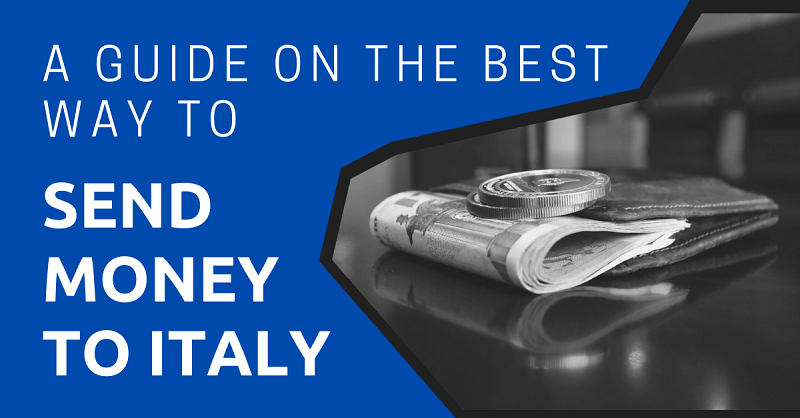
Sending money to Italy doesn’t have to be frustrating. In fact, it’s quite easy when you know how to find the most affordable money transfer service providers.
But narrowing down your picks can be daunting if you don’t know how to calculate exchange rate percentages and transfer fees.
That’s where this guide comes in. We’ve done all the math so you can easily compare the online money transfer services used by expats all over the world to make sure you’re getting the most EUR for your money.
Before you dive into this guide, check out Monito as well. They update their website every day with the latest exchange rates and transfer fees for all the popular service providers, saving you both time and money.
This article will take approximately 12 minutes to read. Don't have the time right now? No worries. You can email the ad-free version of the article to yourself and read it later!
Disclaimer: This article may include links to products or services offered by ExpatDen’s partners, which give us commissions when you click on them. Although this may influence how they appear in the text, we only recommend solutions that we would use in your situation. Read more in our Advertising Disclosure.
Contents
Good to Know
For Americans who have over US$10,000 in their foreign bank account at any time during the year, they must file a FinCEN form 114 when doing their annual taxes.
This law may apply to you as well, depending on which country you come from. If you don’t file, you may have to pay penalties or face jail time.
Either way, it’s good to know whether your government enforces this law because if you transfer a large sum into your Italian bank account, you don’t want to be penalized for it.
What to Watch Out for When Sending Money to Italy
To help you find the right money transfer service to use when sending money to Italy, you have to consider these three things:
- transfer fees
- exchange rates
- transfer speeds
Let’s look at each one in more depth, starting with transfer fees.
Transfer Fees
When you transfer money into Italy from a bank account outside of the country, you have to pay a transfer fee.
These transfer fees are usually disclosed upfront by money transfer service providers, but sometimes they’re hidden.
Moreover, they come in three forms:
- fixed fees
- percentage fees
- combination fees
Let’s dive into each one in more detail.
Fixed Fees
Fixed fees are one form of transfer fees that you could pay when sending money into Italy.
Because the amount of the fee never changes no matter how much you transfer into the county, when sending large amounts (US$10,000 or more) you should find a money transfer service provider that charges fixed fees.
After all, why pay a hefty percentage fee on US$10,000 when you can send that money for one low fixed fee of US$45 — that’s the case when you use Bank of America, who has one of the lowest fixed fees on international transfers in the entire U.S.
That said, let’s look at percentage fees next.
Percentage Fees
Percentage fees increase as the size of you transfer increases, making this an okay fee structure for small transfers into Italy, but not for larger ones.
When sending money to Italy, only use money transfer service providers who charge percentage fees for transfer amounts less than US$10,000.
After all, it doesn’t make sense paying a 5 percent fee of US$500 on a US$10,000 when you can use Bank of America and pay a fixed fee of only US$45 for the same transfer.
Combination Fees
When it comes to all the fees, combination fees are usually the most expensive because they include both fixed and percentage fees.
Two popular money transfer service providers who use combination fees are PayPal and Western Union. Having said that, some banks use this fee structure as well.
It makes sense, then, to ask your bank what their fee structure is, so you don’t wind up paying too much for your international money transfer to Italy.
With all the fees now covered, let’s look at the next important aspect for money transfers – exchange rates.
Exchange Rates
Exchange rates are the buying and selling averages of a specific currency, in this case the currency you have in your home bank account and EUR in Italy.
The goal when sending money to Italy is to get the best exchange rates possible. To do that, compare what the money transfer service provider is willing to give you compared to the mid-market rates on XE.com.
When it comes to getting mid-market rates, Wise stands ahead of the crowd.
However, just because you’re getting mid-market rates doesn’t mean you’ll wind up with the most EUR in your Italian account. You have to consider both transfer fees and exchange rates.
With that said, let’s go onto transfer speeds.
Transfer Speeds
Finally, we now come to transfer speeds. Transfer speeds may not affect how many EUR you get in your Italian bank account, but it does affect how long it takes to arrive.
Some money transfer services like PayPal’s Xoom and Western Union only take minutes for international transfers. However, their fees are much higher and they don’t offer mid-market exchange rates.
Wise, XendPay, and most banks are generally slower (hours or days compared to minutes), but you pay fewer transfer fees and get closer to mid-market exchange rates when using those service providers.
Having said all that, we can now cover what you’re here for – the money transfer service options.
Money Transfer Service Options
In order to get the most EUR in your bank account, you have to pick a money transfer service provider that has the lowest fees and best exchange rates.
Let’s see how the most popular ones add up, starting with XendPay
XendPay
XendPay gives you the most EUR in your bank account when sending lower than US$10,000 to Italy.

The online money transfer service provider doesn’t offer mid-market exchange rates, but its “free” transfer for the first US$2,275 you send to Italy means you get more cash on the receiving end.
However, one you go over the US$2,275 limit, XendPay charges anywhere from 0.41 percent to 1.5 percent in transfer fees. When it comes to exchange rates, it takes 2 percent to 3 percent of the mid-market exchange rates.
So, if you transfer US$1,000 to your Italian bank account, you wind up with EUR885 in the end, making it the most affordable online money transfer service provider for first-time users.
Wise
For international money transfers into Italy, Wise comes in just below XendPay, making it the second-best choice on this list.

When sending US$1,000 to Italy Wise gives you mid-market exchange rates and charges the following fees on top of its US$4.79 percentage fee:
- bank debit — US$1.60 fee
- wire transfer — US$4.14 fee
- debit card — US$12.05 fee
- credit card — US$38.92 fee
Considering all that, you get EUR881.67 in your Italian bank account when sending US$1,000 to Italy using Wise’s bank debit method.
Check out our in-depth review of Wise to find out how it can help you save money on your next international money transfer.
Bank Transfers
When it comes to sending money to Italy from your home country ban account, bank transfers are usually the best choice, especially for amounts over US$10,000.
Citibank account holders get the best rates for bank transfers, as it charges just US$25 for international transfers into Italy. Citigold or Citi Priority account holders pay only US$17.50. And Citigold Private Clients pay zero dollars in transfer fees.
As for exchange rates, Citibank charges between 0.01 percent to 0.5 percent of mid-market exchange rates. However, it still turns out to be the cheapest method for large transfer amounts.
When using Citibank, you get EUR871.89 for US$1,000 transfers and EUR8,920.14 for US$10,000 transfers.
Citibank is clearly the better choice for US$10,000 transfers, but for lesser amounts, go with Wise or XendPay.
Xoom (PayPal)
PayPal’s Xoom is similar to Western Union in that it’s fast and reliable, but it is definitely not the cheapest method when sending money to Italy.

Although it don’t disclose exactly how much its exchange rates fees are, Xoom does say that it rounds them up to the nearest whole EUR. When looking at the exchange rate fee on its website, we can calculate that Xoom takes 2 percent to 4 percent of the mid-market rates.
Moreover, Xoom charges US$30.49 in debit or credit card fees when you pay for the transfer using one of those methods.
So, if you send US$1,000 to Italy using Xoom, you get EUR868 in your Italian bank account – ranking Xoom lower than XendPay and Wise but higher Western Union.
Western Union
Western Union is one of the more established money transfer service providers on this list, but at the same time it comes in as one of the more expensive.

To start, Western Union charges 2.5 percent of the mid-market rates as exchange rate fees. Moreover, its transfer fees are structured like this:
- credit card — US$29.99
- debit card — US$2.99
- bank debit — US$0.99
When you send US$1,000 through Western Union into Italy, that leaves you with only EUR865.30, which is nearly EUR20 less than what XendPay or Wise would give you.
On top of that, you have a transfer limit of US$50,000 when using Western Union to send money to Italy. So, for large purchases like condos, houses, or property, you’re best bet is to use a bank transfer.
ATM Withdrawals
In Italy, you can use your ATM card to take cash out of mostly every ATM in the country – but be prepared to pay.
ATM fees in Italy run between US$2.50 and U$5, but it’s not unheard of to pay up to US$10 to withdraw cash from an ATM. You also have to consider the fee that your home country bank charges.
To avoid ATM fees while in Italy, open a bank account at TD Bank or Charles Schwab in the U.S. or Canada, or Metro Bank in the U.K. These banks reimburse for all international ATM fees.
In Italy, you can withdraw up to EUR250 per day, depending on the ATM.
Cryptocurrencies
Cryptocurrencies are legal in Italy, which, in fact, is one of the first countries to oversee the digital asset at the legislative level.
That said, currently there are ATMs all over Italy that let you exchange 11 types of cryptocurrencies for EUR.
The Best Method to Send Money To Italy
In general, using XendPay is the most cost effective way to send money to Italy from your home country bank account. However, for large transfers of US$10,000 or more, it’s better to go with a bank transfer.
| Method | Speed | US$1,000 | US$10,000 |
|---|---|---|---|
| XendPay | 1 to 3 Days | EUR885 | EUR8,856 |
| Wise | 1 to 3 Days | EUR881.67 | EUR8,820.92 |
| Xoom | 1 Day | EUR868 | EUR8,680 |
| Citibank | 2 to 3 Days | EUR871.86 | EUR8,920.14 |
| Western Union | 1 to 4 Days | EUR865.30 | NA |
With that out of the way, let’s look at some country-specific recommendations.
Country-Specific Recommendations
When sending money to Italy from the U.S., U.K, or Canada, here are your best choices.
United States
For American expats, XendPay is the best method to transfer money from a bank account in the U.S. to a bank account in Italy.
For transfers over US$10,000, then Citibank is the cheapest choice on the lost. With its US$25 international transfer fees, it remains as one of the most cost effective methods for large international money transfers.
United Kingdom
XendPay comes in the most affordable way to send money from the U.K. to a bank account in Italy, especially for first-time senders as you get free transfers on the first GBP2,000 you send to Italy.
For larger transfers of GBP10,000 or more, Lloyds Bank, which only charges GBP9.50 for international money transfers, is the way to go.
Canada
XendPay comes in first place for Canadians looking to send money to an Italian bank account.
But as you get closer to CAD10,000, use RBC Royal Bank for your international money transfers, as they only charge CAD10 for transfers from Canada to Italy.
Now, on to You
By now, you should know which money transfer service method is the cheapest for sending money to Mexico.
Knowing this helps you make the best decision for your financial scenario and hopefully yields the highest amount on the receiving end.
Lastly, always remember to check Monito before committing to an online money transfer service provider. They keep an up-to-date list of all the latest exchange rates and transfer fees for the popular service providers.







